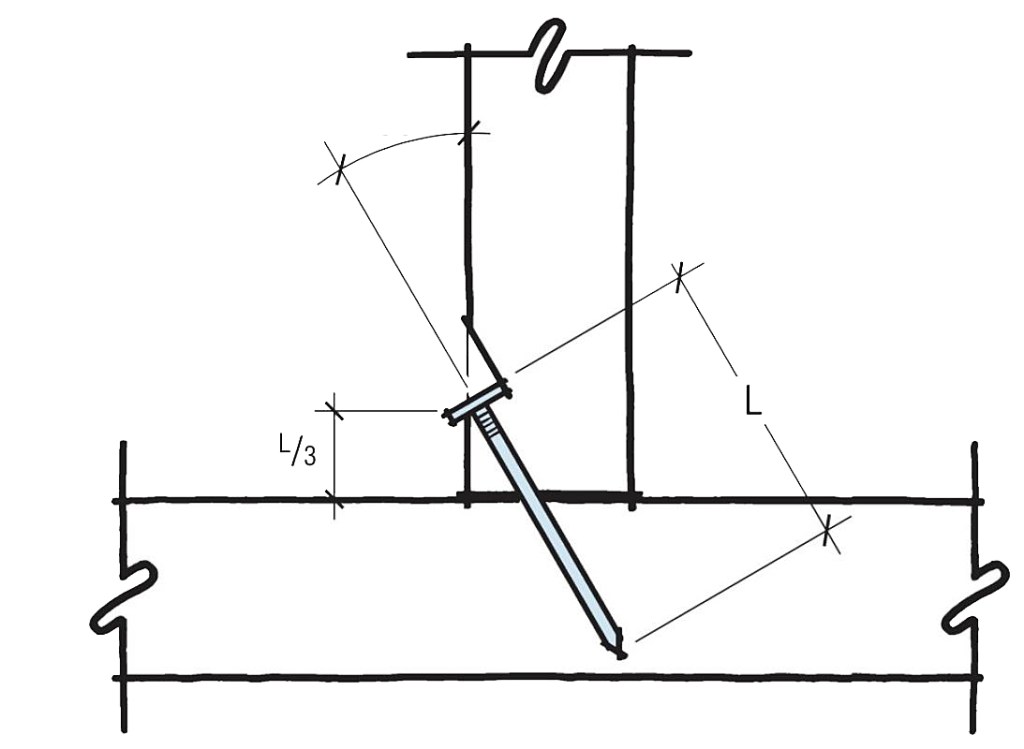Q: My crew often has questions about nailing studs when we build walls. For starters, the code is specific about the number and size of nails for end-nailing wall plates to studs but doesn’t specify the size of the studs. Do the same number of nails apply for 2×4 and 2×6 studs? How about for 2x8s in fat walls? Also, what’s the correct angle for toenailing studs to plates? Is the goal to drive the nail through the center of the end of the stud or near the far corner
A: Don Dunkley, a former framing contractor and long-time JLC contributor responds: It’s true, Table R602.3(1), which specifies the fastening schedules for wall construction in the International Residential Code, does not differentiate between 2×4 and 2×6 studs. Whenever I’m dealing with the code, I am careful to not assume anything beyond what is written.
Since the stud size is not called out, the column “Number and Type of Fastener” implies both sizes of studs are included in the fastening schedule because they are not individually called out in the “Description of Building Elements” column. (For comparison, refer to Table R602.3(5) in the same code chapter, where it does differentiate between 2×4, 3×4, 2×5, and 2×6 for determining the height and spacing of wood studs. Here, the stud size is critical for lateral strength. Nails in stud-to-plate connections primarily resist against uplift and, frankly, they don’t provide a great deal of resistance, particularly with nails into end grain. When uplift and shear resistance matter in high-wind and seismic zones, code looks to sheathing-to-framing connections and to hold-downs, tension ties, and other framing hardware. And jurisdictions in these zones mostly require engineered solutions that go beyond any prescriptive measures.)
It’s worth noting, a similar situation applies to the “Floor Joist” column for number and type of fastener, also called out in Table R602.3(1). The nailing schedule shown is the same for all common-width joists, since no particular joist width is being defined or called out in the “Description of Building Elements” column. Here, as with studs, the table implies the number and size of the fasteners applies regardless of the size of the joist.
Concerning specialty walls, end-nailing into 2×8 and larger width studs isn’t covered specifically so if your jurisdiction doesn’t require stamped engineering details on the building plans for these, drive in a few extra nails as a best practices rule of thumb.
For the question on toenailing, a nail driven at an angle coming out the bottom of the stud close to its center will provide the strongest connection. This is what the American Wood Council tests to determine the strength of toenail connections in the National Design Specification. Nails that exit the far corner may not penetrate the plate deep enough to provide sufficient holding power.
My personal preference for toenails is hand-nailing with 8d sinkers (2 1/2-in. x 0.113-in.). I find they are the easiest to place and start for a roughly 45-degree exit at the center. (The angle would need to be steeper with a longer nail, as shown in the illustration, below). Practice makes perfect for speed and accuracy.
Keep the conversation going—sign up to our newsletter for exclusive content and updates. Sign up for free.
